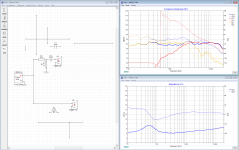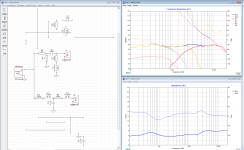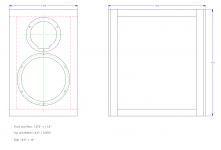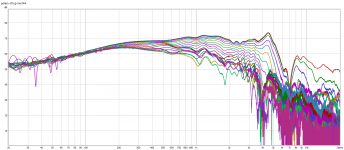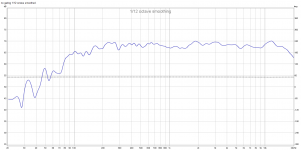I have a Morel CAW 538 and CAT 378 I am trying to design into a 2-way bookshelf in a 7L bass-reflex enclosure tuned to around 42Hz. I know if I flush mount the tweeter and surface mount the woofer I will have near perfect time alignment. It is coming down to the crossover and I wanted to bounce a few ideas off the forum because I see two strategies.
First strategy is to do a simple 2nd Order LR Filter at 2500Hz with an L-Pad on the tweeter and call it a day.
Second strategy is a little more ambitious, but I think may yield a better result and take advantage of the excellent FR of these drivers. I think I can get away with a Dynaco A25-esque design. The woofer has a nice rolloff starting around 4000Hz with a small peak around 8000Hz (cone breakup?). My idea would be to address this with a 1st-order filter around 5-6kHz to make sure it is far enough down it will be inaudible with a simple 0.5mH coil (impedance is about 13 ohm at this frequency). Then use a 1st order on the tweeter around 7000Hz. I say 7000Hz and not 4000Hz because the tweeter has a subtle rise (going backwards towards the crossover point) from 6000Hz-3000Hz that could be nullified by the gentle slope of a 1st order crossover. I would likely use 2.2uF cap. Am I crazy or would something like this work and give better transients?
Background: I have been building DIY speakers for a few years now. I know my way around a schematic, am handy with a soldering iron, and now feel ready to cut my teeth with a design of my own.
First strategy is to do a simple 2nd Order LR Filter at 2500Hz with an L-Pad on the tweeter and call it a day.
Second strategy is a little more ambitious, but I think may yield a better result and take advantage of the excellent FR of these drivers. I think I can get away with a Dynaco A25-esque design. The woofer has a nice rolloff starting around 4000Hz with a small peak around 8000Hz (cone breakup?). My idea would be to address this with a 1st-order filter around 5-6kHz to make sure it is far enough down it will be inaudible with a simple 0.5mH coil (impedance is about 13 ohm at this frequency). Then use a 1st order on the tweeter around 7000Hz. I say 7000Hz and not 4000Hz because the tweeter has a subtle rise (going backwards towards the crossover point) from 6000Hz-3000Hz that could be nullified by the gentle slope of a 1st order crossover. I would likely use 2.2uF cap. Am I crazy or would something like this work and give better transients?
Background: I have been building DIY speakers for a few years now. I know my way around a schematic, am handy with a soldering iron, and now feel ready to cut my teeth with a design of my own.
A concern with your second idea is that this speaker is directional at 4k, moreso than the tweeter. At first glance it may seem like a good place to have a power dip, but it could make the treble heavy at and above 4k.
As for breakup, I'd be looking to get 5k far down.
As for breakup, I'd be looking to get 5k far down.
A concern with your second idea is that this speaker is directional at 4k, moreso than the tweeter. At first glance it may seem like a good place to have a power dip, but it could make the treble heavy at and above 4k.
As for breakup, I'd be looking to get 5k far down.
I hadn't considered directionality, but the tweeter is very directional as well so I don't think that will be an issue. I forgot to mention, but I will use an L-Pad on the tweeter in this configuration.
There shouldn't be a power dip at 4k. The tweeter has a slight (5-6dB) rise around 4K so the idea was to move its crossover point a little higher and take advantage of the gradual slope of a 1st-order crossover to stamp it out.
With this in mind, are there any glaring issues with this idea? Suggestions for improvements?
If your aim was to get a flat response, then that is a reasonable goal. The method is fine.. On the other hand how is this different to using less components to complement the natural roll off the woofer. Is this better in this respect than a 2,500 cross?The tweeter has a slight (5-6dB) rise around 4K so the idea was to move its crossover point a little higher and take advantage of the gradual slope of a 1st-order crossover to stamp it out.
On the other hand how is this different to using less components to complement the natural roll off the woofer. Is this better in this respect than a 2,500 cross?
I'm not sure if I understand what you are saying. I think this is the fewest amount of components I can use. A cap on the tweeter and (if needed to stamp a breakup peak) a coil on the woofer with an L-Pad on the tweeter to attenuate. Can it get any more simple?
As with the point about crossing your tweeter.. whether the rolloff comes from the driver mechanically, electro-mechanically, or by way of extra components the end result is the same. You suggest using less components, but more driver rolloff at the same time. The response and its phase end up the same as if you'd used more components but at a flatter region of the driver aiming at the same overall rolloff.
If it were me I'd probably end up using more components than that as I would want 5k to be sufficiently out of range.
If it were me I'd probably end up using more components than that as I would want 5k to be sufficiently out of range.
Last edited:
Speaking only about electrical order of the crossover makes little sense. You should aim for a specific acoustic slope. In this respect, looking at the spec sheet your horn loaded tweeter can probably be crossed 2nd order LR at some 2.5KHz with only one cap. But I suspect that in order to achieve the same slope on the mid will be more difficult and will require more than a single coil. Time to open a crossover design app (XSim, VituixCAD, Boxsim) and perform some tests.
Ralf
The rolloff of the mid is not gently and need to be addressed properly
Ralf
The rolloff of the mid is not gently and need to be addressed properly
There is always going to be a power dip in a 2way of this size but it'll be much worse if crossed at 4khz compared to 2-2.5khz.There shouldn't be a power dip at 4k.
The closest CTC spacing you can achieve with those drivers is 4.5inches/113mm. At 30degrees off the vertical axis, you already have a path length difference of 56mm which causes deep nulls at 3khz, 6khz and so on. At 90degrees the null is at 1.5khz. So at least if you crossed near 2khz you'd get 60degrees of vertical coverage without any significant dip.
Last edited:
I had a 10" eminence b102 run wide open (naturally 6ddb down at 2khz) with the morel cat 378 with its 5.6uf cap (also 6db down at 2khz).
Sounded really good, but very limited dispersion, couldn't do a couch wide at 7' without losing upper upper mids and maybe 6khz up.
Sounded really good, but very limited dispersion, couldn't do a couch wide at 7' without losing upper upper mids and maybe 6khz up.
Doing some sims as Ralf suggests will give you some ideas. If you can do them with actual measurements of your drivers all the better. My MW144's response was nothing like the datasheet and in the end I had to account for some pretty nasty anomalies in their response to get the best sound.
However the first iteration of crossover for them was a single cap on the tweeter and the mw144's running full range (ie no crossover at all). I think it was 3.6uF on the tweeter. They sounded remarkably good even with that very simple setup. Currently I have a 4th order accoustic bessel at 2.8Khz which is superior to all other variations I tried. I found at least with my mw144's and DMS37's that there was only a narrow range of frequencies that I could cross them over successfully. I can probably go lower but definitely not higher.
If your CAW 538's are close to the datasheet response then your job should be a lot easier than mine was 🙂
Tony.
However the first iteration of crossover for them was a single cap on the tweeter and the mw144's running full range (ie no crossover at all). I think it was 3.6uF on the tweeter. They sounded remarkably good even with that very simple setup. Currently I have a 4th order accoustic bessel at 2.8Khz which is superior to all other variations I tried. I found at least with my mw144's and DMS37's that there was only a narrow range of frequencies that I could cross them over successfully. I can probably go lower but definitely not higher.
If your CAW 538's are close to the datasheet response then your job should be a lot easier than mine was 🙂
Tony.
Thanks for all of your insight. I will pull out my old windows laptop and run some simulations tonight. I do have a Dayton DATS I can use to measure the speakers as well as a cheap calibrated mic. Which of the parameters did you find far off from the spec sheet?Doing some sims as Ralf suggests will give you some ideas. If you can do them with actual measurements of your drivers all the better. My MW144's response was nothing like the datasheet and in the end I had to account for some pretty nasty anomalies in their response to get the best sound.
However the first iteration of crossover for them was a single cap on the tweeter and the mw144's running full range (ie no crossover at all). I think it was 3.6uF on the tweeter. They sounded remarkably good even with that very simple setup. Currently I have a 4th order accoustic bessel at 2.8Khz which is superior to all other variations I tried. I found at least with my mw144's and DMS37's that there was only a narrow range of frequencies that I could cross them over successfully. I can probably go lower but definitely not higher.
If your CAW 538's are close to the datasheet response then your job should be a lot easier than mine was 🙂
Tony.
Seeing as the drivers are seemingly descendants of the mw144 and DMS37 I would surprised if they didn't have similar characteristics. What was the range you found most success crossing them over at? I am tempted to just try your crossover point and design, but with the very natural roll off of these drivers it seems like there has to be simpler solution. What made you finally go for a higher order crossover sonically?
Time to open a crossover design app (XSim, VituixCAD, Boxsim) and perform some tests.
I brought these into XSim last night and played around with them for a few hours.
I got interesting results with the simple 1st order on the tweeter. The best overall FR resulted in a higher crossover (3500Hz) which is higher than the driver spacing should allow, but it is so beautifully simple I think I may give it a go.
The 2nd order on the tweeter and 3rd on the woofer worked and used less components than the 4th order filter, but not well enough to justify its use. On paper, the 4th order filter is clearly the best. I forgot to complete the L-Pad on the screen shot I took of this so ignore the impedance plot. When completed it looks good.
Now its time to build the box for the speaker, try and take some measurements of my own, bring them into XSim to see how far they deviate from the manufacturer's, and tweak as needed before buying parts.
Attachments
Very interesting topic, drewrf.
Two excellent drivers here. A Morel CAW 538 5" polycone midbass and a Morel CAT 378 horn-loaded tweeter.
First, IMO, temper your expectations. 😀
Little 5" polycone (aka plastic) basses in small boxes are strictly bedroom speakers:
Epos ELS-3:
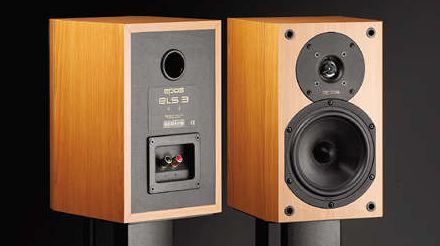
Harbeth P3ESR:
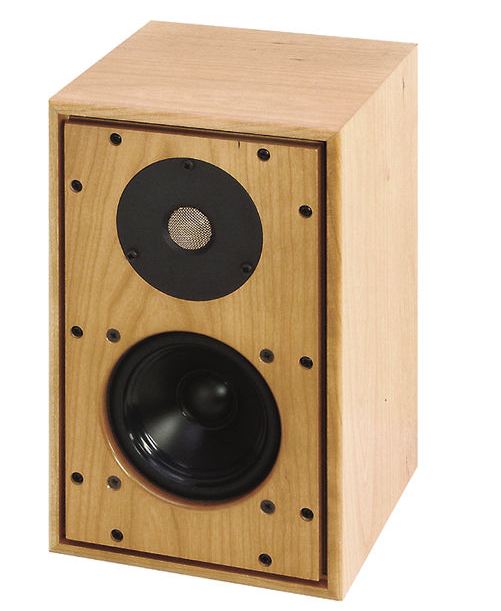
Tiny little speakers like this don't go loud without distortion.
What they do well is reproduce human voices very convincingly, even if the bass is mostly missing in action.
There is a certain amount of mathematical theory behind the two-way speaker:
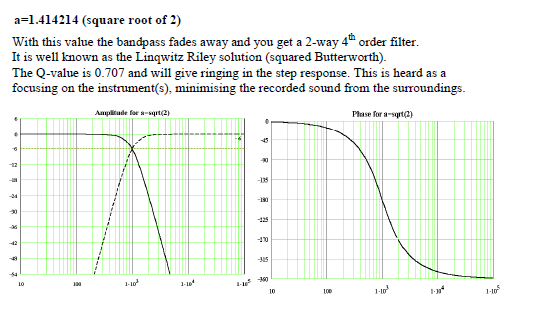
Here's the good news. I have dug up a bass circuit the works well enough for your CAW 538 bass. It's similar to the MW 1448 bass. As it goes, Morel have a US and an Israeli branch, using different catalog numbers. AFAIK, Morel combine a 3" soft dome with a bit of bass ability. Just what they do...
Morel Brand Archives - Madisound Speaker PDF Library
Specifically this one looks like a start: https://www.madisound.com/library/stacks/MW1448-MDT29-4.pdf
Going from a Morel MDT29-4 to a CAT 378 is quite a change, but doable, I feel. A reflex box around 7L sounds reasonable too.
Two excellent drivers here. A Morel CAW 538 5" polycone midbass and a Morel CAT 378 horn-loaded tweeter.
First, IMO, temper your expectations. 😀
Little 5" polycone (aka plastic) basses in small boxes are strictly bedroom speakers:
Epos ELS-3:
Harbeth P3ESR:
Tiny little speakers like this don't go loud without distortion.
What they do well is reproduce human voices very convincingly, even if the bass is mostly missing in action.
There is a certain amount of mathematical theory behind the two-way speaker:
Here's the good news. I have dug up a bass circuit the works well enough for your CAW 538 bass. It's similar to the MW 1448 bass. As it goes, Morel have a US and an Israeli branch, using different catalog numbers. AFAIK, Morel combine a 3" soft dome with a bit of bass ability. Just what they do...
Morel Brand Archives - Madisound Speaker PDF Library
Specifically this one looks like a start: https://www.madisound.com/library/stacks/MW1448-MDT29-4.pdf
Going from a Morel MDT29-4 to a CAT 378 is quite a change, but doable, I feel. A reflex box around 7L sounds reasonable too.
Last edited:
First, IMO, temper your expectations. 😀
Little 5" polycone (aka plastic) basses in small boxes are strictly bedroom speakers:
I live in an apartment so everything is bedroom sized. I also don't listen to my music at high levels either, its just not my taste and as I said before I live in an apartment so I don't want to **** off the neighbors.
I will be paring this with a subwoofer so I'm not worried as much about the lack of deep bass.
Thanks for sharing those links I will see what I can glean from the past designs.
I drew up a little box in CAD over my lunch break today and will see if I can find time this weekend to build one so I can start to play with them and take some measurements.
Attachments
Hi drewrf the problems with my mw144's was big SPL anomalies after 1Khz with the problem centered around a big dip at 2Khz (see attachment). Looks like you don't have that issue at all which is great.
Despite that I managed to develop a crossover that gave me a pretty decent response (and they sound really good), but not without complexity in the crossover. the crossover point I settled on was 2.8Khz This was the frequency where it just was easiest for me to get both drivers playing well together. I have contemplated doing a 2.2Khz crossover, and have run some sims where it seems to work ok as well. My particular MW144's just can't be crossed higher that the 2.8Khz due to their response anomalies, and ideally probably should be crossed much lower. 2nd attachment is of the final speaker, measured outside, no gating, 12/th ocatave smoothed.
For me the biggest plus with the 4h order acoustic at 2.8Khz was that the speakers stayed much clearer at higher levels with dense music.
I augment the low end with a couple of Vifa 10" M26WR09-08's crossed inactively at 270Hz. So effectively a three way, though I did live with the lack of bass (mine are 5L sealed) for a number of years without any regrets.
Tony.
Despite that I managed to develop a crossover that gave me a pretty decent response (and they sound really good), but not without complexity in the crossover. the crossover point I settled on was 2.8Khz This was the frequency where it just was easiest for me to get both drivers playing well together. I have contemplated doing a 2.2Khz crossover, and have run some sims where it seems to work ok as well. My particular MW144's just can't be crossed higher that the 2.8Khz due to their response anomalies, and ideally probably should be crossed much lower. 2nd attachment is of the final speaker, measured outside, no gating, 12/th ocatave smoothed.
For me the biggest plus with the 4h order acoustic at 2.8Khz was that the speakers stayed much clearer at higher levels with dense music.
I augment the low end with a couple of Vifa 10" M26WR09-08's crossed inactively at 270Hz. So effectively a three way, though I did live with the lack of bass (mine are 5L sealed) for a number of years without any regrets.
Tony.
Attachments
Thanks for getting back to me with your experience.
I don't know why I have never considered this. I have cleared furniture out of rooms and hung blankets everywhere. This seems so obvious. Ill be taking this outside to measure.
measured outside, no gating, 12/th ocatave smoothed.
I don't know why I have never considered this. I have cleared furniture out of rooms and hung blankets everywhere. This seems so obvious. Ill be taking this outside to measure.
I am going ported and so I should be well down into the range where I can meet it with my sub.I augment the low end with a couple of Vifa 10" M26WR09-08's crossed inactively at 270Hz. So effectively a three way, though I did live with the lack of bass (mine are 5L sealed) for a number of years without any regrets.
Yes even sealed it would meet up with a sub crossed at 80Hz without too much trouble. Ported you will not have any issues at all.
Tony.
Tony.
Just a bit of blue sky thinking here.
Dynaudio midbasses and tweeters are very similar to Morel ones, I believe Morel license some features from them.
I see Troels Gravesen did some work on the Dynaudio 15W-75/4 and an Esotar tweeter:
Dynaudio 15W75-
Always interesting to see what he does. Here it is a couple of notches on the bass.
You might try the same at about 4 and 8kHz on yours.
Using a waveguide tweeter usually entails smaller capacitors and bigger coils than usual to get the response right:
IDUNN
You'll want an attenuator (3.3R + 6.8R?) in front of the loud tweeter too. This is good to damp the tweeter's Fs resonance too.
I haven't a clue what polarity will be without modelling it, but this looks like a combination that can work with very simple crossover if you aren't too fussy.
Dynaudio midbasses and tweeters are very similar to Morel ones, I believe Morel license some features from them.
I see Troels Gravesen did some work on the Dynaudio 15W-75/4 and an Esotar tweeter:
Dynaudio 15W75-
Always interesting to see what he does. Here it is a couple of notches on the bass.
You might try the same at about 4 and 8kHz on yours.
Using a waveguide tweeter usually entails smaller capacitors and bigger coils than usual to get the response right:
IDUNN
You'll want an attenuator (3.3R + 6.8R?) in front of the loud tweeter too. This is good to damp the tweeter's Fs resonance too.
I haven't a clue what polarity will be without modelling it, but this looks like a combination that can work with very simple crossover if you aren't too fussy.
- Home
- Loudspeakers
- Multi-Way
- Morel 2-Way Design
